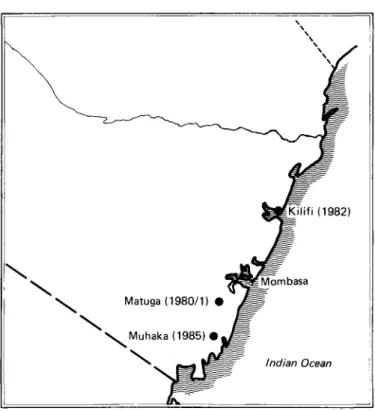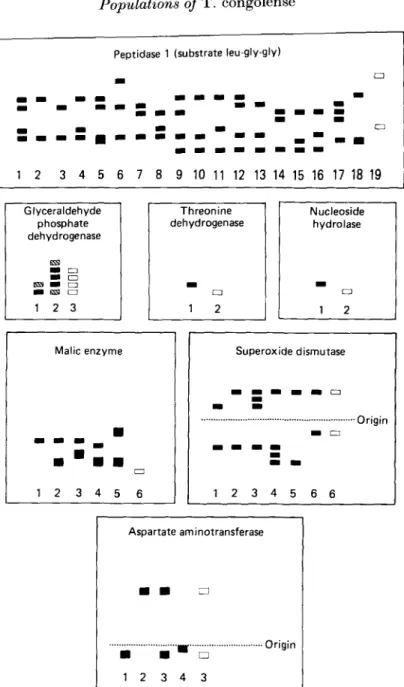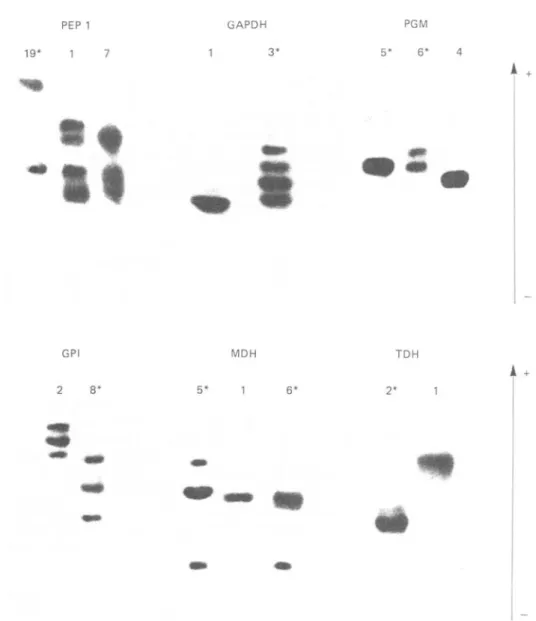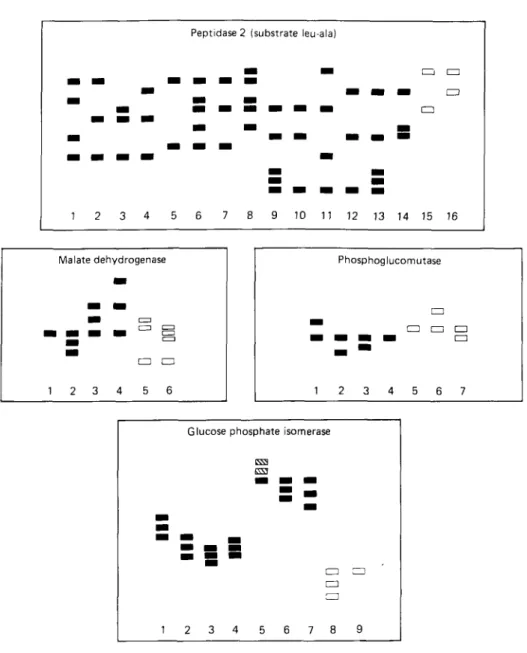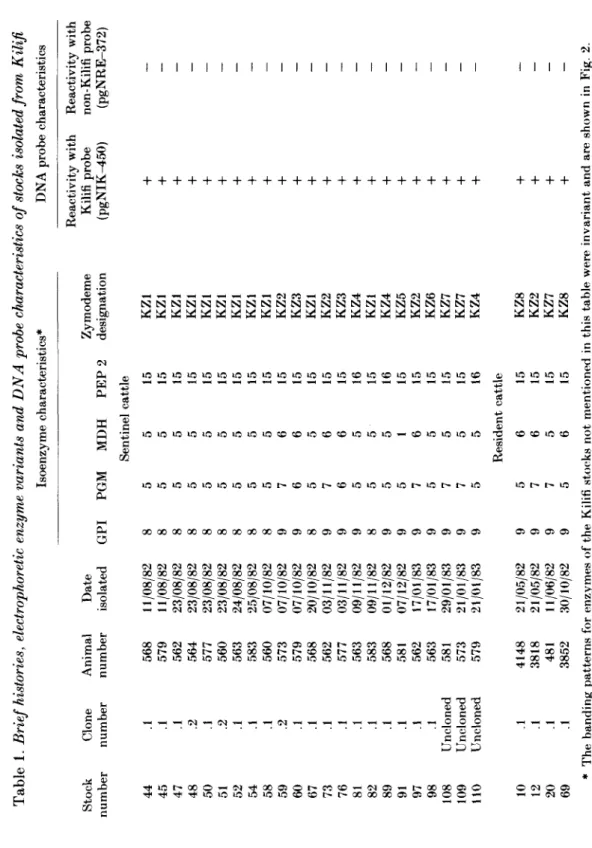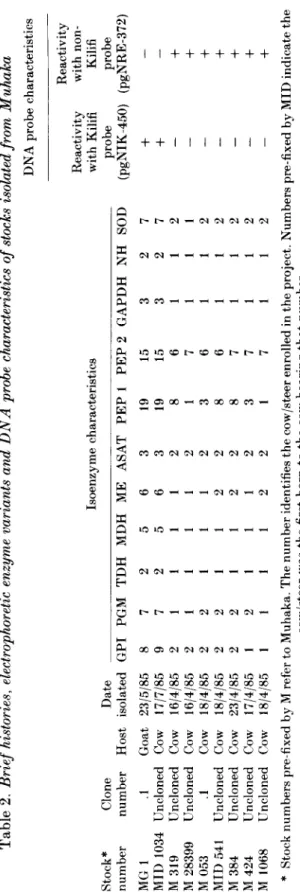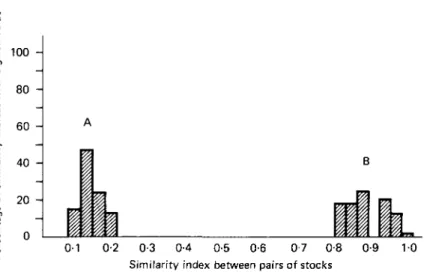Parasitology (1988), 96, 461-474 4 6 1 With 5 figures in the text
Genetically discrete populations of Trypanosoma congolense from
livestock on the Kenyan coast
G. KNOWLES1, B. BETSCHART2, B. A. KUKLA1, J. R. SCOTT1 and
P. A. 0. MAJIWA1
1 International Laboratory for Research on Animal Diseases, P.O. Box 30709,
Nairobi, Kenya
2 Swiss Tropical Institute, Socinstrasse 57, Ch 4051, Basel, Switzerland
{Accepted 17 November 1987)
SUMMARY
Twenty-seven stocks of Nannomonas trypanosomes isolated from livestock in 1982 on a ranch at Kilifi on the Kenyan coast were characterized by isoenzyme electrophoresis and by the abilities of the parasite's DNA to hybridize to two repetitive sequence DNA probes. All the Kilifi stocks which were examined had isoenzyme patterns which were markedly different from the 75 patterns previously described from 78 stocks of Trypanosoma congolense. On average only 15% of the enzyme bands present in the Kilifi stocks were present in those stocks of T. congolense which had previously been surveyed for isoenzymes. The DNA from all the Kilifi stocks which had been examined for isoenzymes hybridized with only the repetitive sequence probe isolated from a clone of a Kilifi stock. In contrast, the DNA from all 27 Kilifi stocks failed to hybridize with a repetitive sequence probe isolated from a clone from a different stock of T. congolense. Thus, the trypanosomes in all the Kilifi stocks examined were both phenotypically and genotypically discrete. These genetically discrete trypanosomes have also been detected in 2 stocks isolated from livestock from another location on the Kenyan coast. The results show that there is a wide range of genetic heterogeneity within the trypanosomes currently classified as T. congolense. We suggest that the limits of this genetic heterogeneity could represent incipient speciation.
INTRODUCTION
The study of enzyme polymorphism in salivarian trypanosomes has revealed much about the genetic composition of populations of these parasites. I t is now clear that there is abundant genetic heterogeneity amongst stocks of Trypanosoma brucei (Gibson, Marshall & Godfrey, 1980; Tait, 1980; Mehlitz, Zillman, Scott & Godfrey, 1982) and T. congolense (Young & Godfrey, 1983) and that in both these species, the distribution of genetic heterogeneity is not uniform across Africa. For example, in T. brucei the frequencies of electrophoretic variants of the enzymes phospho-glucomutase (PGM) and isocitrate dehydrogenase (ICD) are different between stocks from East and West Africa (Gibson et al. 1980). There are also marked genetic differences between stocks of T. congolense originating from the humid regions of West Africa compared with stocks from arid savanna areas of Africa (Young & Godfrey, 1983). Within T. congolense, the major differences between stocks originating from humid and savanna areas were in the frequencies of electrophoretic variants of PGM and peptidase. In Young & Godfrey's (1983) study, stocks from coastal East Africa were not included. However, a later study briefly reported that two stocks of T. congolense taken from the coast of Kenya were genetically distinct from other stocks of T. congolense (Gashumba, 1986). Majiwa, Hamers, Van Meirvenne & Matthyssens
462 G. KNOWLES AND OTHERS Kilifi (1982) \ >v Matuga (1980/1) V Muhaka (1985) 4 \ Indian Ocean
Fig. 1. Map to show the location of Kilifi, Muhaka and Matuga in the Kenyan coastal region. The year of collection of isolates at each location is given in parentheses.
(1986) have also shown that stocks from a coastal site in Kenya were genotypically different from other stocks of T. congolense.
In this paper we report on the electrophoretic variation of enzymes found in stocks of T. congolense taken from two areas on the coast of Kenya. We show that a collection of stocks from Kilifi consisted exclusively of a phenotypically discrete group of Nanno-monas parasites. In contrast, in another coastal area of Kenya these phenotypically discrete parasites were not exclusively present since trypanosomes with other pheno-types were also detected. We also show that the DNA from the parasite from Kilifi contained a repetitive DNA sequence which was absent from other stocks of
T. congolense.
MATERIALS AND METHODS
Study areas
Trypanosomes were isolated from livestock at Kilifi and Muhaka situated on the Kenyan coast; their locations are shown in Fig. 1. A detailed description of the Kilifi study area was given by Paling, Leak, Katende, Kamunya & Moloo (1987) and for the Muhaka study area by Maloo, Kimotho, Chema, Koskey, Trail & Murray (1985).
Sampling of trypanosome-infected cattle in the field
Most of the trypanosome isolations were made from livestock which provided material from two projects which had different sampling strategies.
Populations of T. congolense 463 documented by Paling et al. (1987). Briefly, in mid 1982, twenty Boran steers were introduced as a sentinel herd into the study area from a location outside the tsetse infested region. The sentinel cattle were exposed to tsetse in the Kilifi area from 26th July 1982 to 24th January 1983. In addition to isolations of trypanosomes from the sentinel cattle, trypanosomes were also isolated from some of the resident cattle which had been in the area for varying periods of time. Each week, the sentinel cattle were screened for infection with trypanosomes by the buffy coat concentration method (Murray, Murray & Mclntyre, 1977). If positive, a blood sample was cryopreserved. After cattle had been diagnosed as infected with trypanosomes they were treated with Berenil (6 mg/kg).
Cattle sampled at Muhaka were part of a village-based, chemoprophylactic trial with Isometamidium chloride (Samorin). Seventeen herds comprising about 700 cattle from three villages within an area of 100 sq. km were enrolled in the trial. Cattle in the trial were brought to a central point once a month where blood was taken from an ear vein and screened for trypanosomes by the buffy coat centrifugation method (Murray et al. 1977). At the same time, a venous blood sample was taken and cryopreserved if the ear blood contained trypanosomes.
Growth of trypanosomes in laboratory animals
Cryopreserved blood was inoculated into irradiated (600 rad) mice. Several strains of mice from the ILRAD colony were used during the course of this study. Some of the parasite stocks have been cloned by the hanging drop method; analysis of such cloned stocks is indicated in the results.
Preparation of trypanosomes for enzyme electrophoresis and hybridization of parasite DNA with repetitive DNA probes
At peak parasitaemia, mice were bled and the trypanosomes separated from blood by chromatography on DEAE cellulose (Lanham & Godfrey, 1970).
The preparation and storage of water-soluble enzymes from lysates of pelleted trypanosomes were described by Gibson, Mehlitz, Lanham & Godfrey (1978). For hybridization experiments the purified trypanosomes were pelleted and then suspended
at a concentration of 107 cells/ml in phosphate-buffered saline, pH 8, and stored at
- 8 0 °C.
Starch-gel electrophoresis of enzymes
Electrophoresis was carried out on thin-layer starch gels. Parasite lysate was absorbed onto cotton threads which were then inserted into the gels. This method was first described by Wraxall & Culliford (1968) and used for trypanosomes by Kilgour & Godfrey (1973). The enzymes studied were EC 1.1.1.103, threonine dehydrogenase (TDH); EC 3.2.2.1, purine nucleoside hydrolase (NH); EC 1.2.1.12, glyceraldehyde phosphate dehydrogenase (GAPDH); EC 2.6.1.1, aspartate amino transferase (ASAT): EC 2.7.5.1, phosphoglucomutase (PGM); EC 1.1.1.40, malic enzyme (ME); EC 1.1.1.37, malate dehydrogenase (MDH); EC 5.3.1.9, glucose phosphate isomerase (GPI); EC 1.15.1.1, superoxide dismutase (SOD); EC 3.4.11, two peptidase sub-strates L-leucylglycylglycine (PEP 1) and substrate L-leucylalanine (PEP 2). The electrophoretic conditions and staining procedures to reveal enzymic activity were those given by Young & Godfrey (1983).
464 G. KNOWLES AND OTHERS
Hybridization of parasite DNA with repetitive DNA probes
Procedures for the isolation of the two repetitive sequence probes used in this study were given by Majiwa, Masake, Nantulya, Hamers & Matthyssens (1985). One probe which was isolated from a cloned Kilifi stock is coded pgNIK-450 and the other probe is coded pgNRE-372. Both probe sequences are approximately 400 base pairs in length and occur about 2500 times per haploid genome (Majiwa et al. 1985). Suspensions of purified trypanosomes were applied (100/^1 of suspension) to two nitrocellulose filters using the Minifold I I apparatus (Schleicher and Schuel, Keene, NH) essentially as described by Kukla, Majiwa, Young, Moloo & ole-MoiYoi (1987). Each of the two filters were processed and subsequently hybridized with one of the radioisotope-labelled
repetitive DNA probes (specific activities: 1-2 x 108 c.p.m.j/ig DNA) following the
established procedures described by Maniatis, Fritsch & Sambrook (1982).
Post-hybridization washes to remove non-specifically bound probe were performed at 65 °C with 0-1 x SSC (15 mM sodium chloride, 0-15 mM trisodium citrate, 0-1% (w/v) sodium dodecyl sulphate (pH 7'6)). After the washes, the filters were autoradiographed with intensifying screens at — 70 °C.
Calculation of similarity indices
Calculation of similarity indices between pairs of zymodemes were based on the assumptions set out by Gibson et al. (1980). Briefly, each constituent band of enzyme activity which contributed to a pattern type was considered as a unit character. The total number of bands for 9 enzymes which were common between a pair of zymodemes was then calculated. The enzyme bands of TDH, NH, GAPDH, ASAT, ME, MDH, GPI, PEP 1 and PEP 2 were used to calculate the similarity indices. Two sets of similarity indices were calculated; one set for each possible pair of zymodemes found within the Kilifi stocks, and a second set in which each different zymodeme found within the Kilifi stocks was paired with those zymodemes of T. congolense defined by Young & Godfrey (1983).
RESULTS
Characterization of Kilifi stocks Enzyme analysis
Twenty-seven stocks from Kilifi were studied for electrophoretic variation in 10 enzymes. In the Kilifi stocks, 7 enzymes (PEP 1, GAPDH, TDH, NH, ME, SOD and ASAT) were electrophoretically invariant (Fig. 2). The banding patterns of 5 of these electrophoretically invariant enzymes (PEP 1, GAPDH, TDH, NH, ME) were different from the banding patterns observed in those stocks described by Young & Godfrey, (1983; Fig. 2 and Fig. 3 for a photograph of gels of P E P 1, TDH and GAPDH). The invariant pattern in the Kilifi stocks for the enzyme SOD type 6 was the same as that described previously for 2-stocks from coastal East Africa (Gashumba, 1986; Fig. 2). The banding pattern for the enzyme ASAT which was invariant in the Kilifi stocks was indistinguishable from the pattern type 3 which was described by Young & Godfrey (1983; Fig. 2).
In the Kilifi stocks 4 enzymes (PEP 2, MDH, PGM and GPI) were electrophoretically variant. The banding patterns for these polymorphic enzymes and also those patterns
Populations ofi. congolense 465
Peptidase 1 (substrate leu-gly-gly)
1 2 3 4 5 6 7 8 9 10 11 12 13 14 15 16 17 18 19 Glyceraldehyde phosphate dehydrogenase 1 2 3 Threonine dehydrogenase 2 Nucleoside hydrolase CD 1 2 Malic enzyme 1 2 3 4 5 6 Superoxide dismutase •Origin 1 2 3 4 5 6 6 Aspartate aminotransferase • • - • H U • 1 2 3 4 3 Origin
Fig. 2. Banding patterns of enzymes which were electrophoretically invariant amongst the Kilifi stocks. (D), Banding patterns of enzymes in the Kilifi stocks; ( H S ) , banding patterns of enzymes described by Young & Godfrey (1983) except for the enzyme SOD which was taken from Gashumba (1986).
which were described previously by Young & Godfrey (1983) for the same enzymes are shown in Fig. 4; photographs of some of these enzyme patterns are shown in Fig. 3. Some of the bands which comprise the patterns of the polymorphic enzymes present in the Kilifi stocks were not observed in the stocks examined by Young & Godfrey (1983); for example, the bands comprising GPI types 8 and 9, PGM types 5 and 6, and the cathodal band near the origin of MDH types 5 and 6 (Figs. 3 and 4). The different combinations of the enzyme electrophoretic variants present in each Kilifi stock are listed in Table 1. Amongst the 27 stocks examined, the 4 variant enzymes were present
466
PEP 1
19* 1 7
G. KNOWLES AND OTHERS
GAPDH PGM 1 3* 5* 6* 4
II
I
GPI 2 8* MDH 5* 1 6* TDH 2* 1Fig. 3. An enzyme type number with an asterisk denotes a banding pattern which was present in the Kilifi stocks and the two Muhaka stocks. Other enumerated enzyme banding patterns are representative of those other stocks of Trypanosoma congolense and were previously described by Young & Godfrey (1983).
in 8 different combinations or zymodemes. Trypanosomes expressing the enzymes which characterize the zymodeme KZl were present in all the stocks which were isolated from the sentinel cattle between 11 and 25 August (Table 1). In contrast, only 3 stocks out of a total of 15 stocks isolated after August belonged to the KZl zymodeme (Table 1). The probability of obtaining such an unequal distribution of the KZl zymodeme and other zymodemes in the Kilifi stocks between August and other months was calculated using Fisher's Exact Test (Conover, 1971) and found to be 0-0003.
Populations o/T. congolense 467
Peptidase 2 (substrate leu-ala)
CD • 1 2 3 4 5 6 7 9 10 11 12 13 14 15 16 Malate dehydrogenase CD CD 1 2 3 4 5 6 Phosphoglucomutase CD CD CD CD 1 2 3 4 5 6 7
Glucose phosphate isomerase
CD CD CD
1 2 3 4 5 6 7 8 9
Fig. 4. Banding patterns of enzymes which were electrophoretically variant amongst the Kilifi stocks. (•)> Banding patterns of enzymes in Kilifi stocks; ( B S ) , banding patterns of enzymes described by Young & Godfrey (1983).
Hybridization of parasite DNA with DNA probes
The abilities of the DNA from the Kilifi stocks to hybridize with the Kilifi and non-Kilifi DNA probes are shown in Table 1. DNA from the 27 non-Kilifi stocks hybridized only with the Kilifi probe and no hybridization was observed between the DNA of the Kilifi stocks and the non-Kilifi DNA probe.
Tabl e 1 . Brief histories, electrophoretic enzyme variants and DNA probe characteristics of stocks isolated from Kilifi Isoenzym e characteristics * DN A prob e characteristic s Q C Stoc k numbe r 4 4 4 5 4 7 4 8 5 0 5 1 5 2 54 5 8 5 9 6 0 6 7 7 3 76 81 8 2 8 9 9 1 9 7 9 8 10 8 10 9 11 0 10 12 2 0 69 Clon e numbe r .1 .1 .1 .2 .1 .2 .1 .1 .1 .2 .1 .1 .1 .1 .1 .1 .1 .1 .1 .1 Unclone d Unclone d Unclone d .1 .1 .1 .1 Anima l numbe r 56 8 57 9 56 2 56 4 57 7 56 0 56 3 58 3 56 0 57 3 57 9 56 8 56 2 57 7 56 3 58 3 56 8 58 1 56 2 56 3 58 1 57 3 57 9 414 8 381 8 48 1 385 2 Dat e isolate d 11/08/8 2 11/08/8 2 23/08/8 2 23/08/8 2 23/08/8 2 23/08/8 2 24/08/8 2 25/08/8 2 07/10/8 2 07/10/8 2 07/10/8 2 20/10/8 2 03/11/8 2 03/11/8 2 09/11/8 2 09/11/8 2 01/12/8 2 07/12/8 2 17/01/8 3 17/01/8 3 29/01/8 3 21/01/8 3 21/01/8 3 21/05/8 2 21/05/8 2 11/06/8 2 30/10/8 2 GP I 8 8 8 8 8 8 8 8 8 9 9 8 9 9 9 8 9 9 9 9 9 9 9 9 9 9 9 PG M 5 5 5 5 5 5 5 5 5 7 6 5 7 6 5 5 5 5 7 5 7 7 5 5 7 7 5 MD H Sentine l 5 5 5 5 5 5 5 5 5 6 6 5 6 6 5 5 5 1 6 5 5 5 5 Residen t 6 6 5 6 PE P 2 cattl e 15 15 15 15 15 15 15 15 15 15 15 15 15 15 16 15 16 15 15 15 15 15 16 cattl e 15 15 15 15 Zymodem e designatio n KZ 1 KZ 1 KZ 1 KZ 1 KZ 1 KZ 1 KZ 1 KZ 1 KZ 1 KZ 2 KZ 3 KZ 1 KZ 2 KZ 3 KZ 4 KZ 1 KZ 4 KZ 5 KZ 2 KZ 6 KZ 7 KZ 7 KZ 4 KZ 8 KZ 2 KZ 7 KZ 8 Reactivit y wit h Reactivit y wit h Kilif i prob e non-Kilif i prob e (pgNIK-^50 ) (pgNRE-372 ) as o * Th e bandin g pattern s fo r enzyme s o f th e Kilif i stock s no t mentione d i n thi s tabl e wer e invarian t an d ar e show n i n Fig . 2 .
Populations o/T. congolense 469 Characterization of Muhaka stocks
Enzyme analysis
Nine stocks from Muhaka were characterized for electrophoretic variation of enzymes. The results are shown in Table 2. One Muhaka stock, from cow MID 1034, had the same electrophoretic enzyme variants as present in the zymodeme designated KZ7 (see Table 1). The stock MG1.1, which was isolated from a goat, had banding patterns for all the enzymes studied which were also present in the Kilifi stocks. However, the combination of the enzymes GPI type 8, with PGM type 7, found in the stock MG1.1, was not found amongst the Kilifi stocks.
The other 7 Muhaka stocks had individual enzyme banding patterns which were amongst those previously described by Young & Godfrey (1983).
Hybridization of parasite DNA with DNA probes
DNA from 2 Muhaka stocks, MID 1034 and MG1.1, hybridized to DNA from the Kilifi probe and did not hybridize to the DNA from the non-Kilifi probe (Table 2). The other 7 Muhaka stocks hybridized only to the non-Kilifi probe (Table 2).
Comparison of similarity indices between the zymodemes of the Kilifi stocks and zymodemes of other stocks of T. congolense
The results are plotted as a frequency histogram of similarity indices. A comparison between the 8 zymodemes represented by the Kilifi stocks and the 2 Muhaka stocks which were similar to the Kilifi parasites with all those zymodemes described by Young & Godfrey (1983) gave similarity indices ranging from 0-1 to 0-2 (Pig. 5A). The mode of this distribution was 0-14, indicating that most of the zymodemes present in the Kilifi stocks shared only 14% of their enzyme bands with the other zymodemes of T. congolense. Values of the similarity indices arising from a comparison of zymodemes within the Kilifi stocks (including the 2 additional Kilifi-like zymodemes from Muhaka)
ranged from 0-8 to 1-0, thus showing that these zymodemes were very similar to each
other (Fig. 5B).
DISCUSSION
In this study we have presented data which identified a discrete genetic group of Nannomonas trypanosomes which predominated at Kilifi in 1982. Parasites with similar phenotypes were also detected at a lower frequency at Muhaka.
These trypanosomes have electrophoretic variants of several enzymes which were not observed in other stocks of T. congolense. Three enzymes (TDH, NH and phospho-fructokinase) were electrophoretically invariant amongst 78 stocks of T. congolense and it was postulated that these enzymes were probably invariant in this species (Young & Godfrey, 1983). In our study we found that all the Kilifi stocks and 2 Muhaka stocks expressed electrophoretic variants of TDH and NH which were different from those expressed in 78 stocks of T. congolense. We did not investigate phosphofructokinase. Also distinctive in the Kilifi stocks were the enzyme bands which comprise PGM types 5 and 6, GPI types 8 and 9, the cathodal band of MDH types 5 and 6 and ME type 6. These bands were absent from the enzyme patterns of those stocks of T. congolense studied by Young & Godfrey (1983).
In addition to all the Kilifi stocks possessing distinctive enzyme electrophoretic variants, their DNA hybridized specifically with the pg NIK-450 repetitive DNA
Tabl e 2 . Brief histories, electrophoretic enzyme variants and DNA probe characteristics of stocks isolated from Muhaka DN A prob e characteristic s Stock * numbe r M G 1 MI D 103 4 M31 9 M 2839 9 M05 3 MI D 54 1 M38 4 M 42 4 M 106 8 Clon e numbe r .1 Unclone d Unclone d Unclone d .1 Unclone d Unclone d Unclone d Unclone d Hos t Goa t Co w Co w Co w Co w Co w Co w Co w Co w Dat e isolate d 23/5/8 5 17/7/8 5 16/4/8 5 16/4/8 5 18/4/8 5 18/4/8 5 23/4/8 5 17/4/8 5 18/4/8 5 GP I 8 9 2 2 2 2 2 1 1 PG M TD H MD H 7 2 5 7 2 5 1 1 2 2 2 2 1 I I I Isoenzym e characteristic s M E 6 6 1 1 1 2 2 1 2 ASA T 3 3 2 2 2 2 2 2 2 PEP 1 19 19 8 1 3 8 8 3 1 PE P 2 15 15 6 7 6 6 7 7 7 GAPD H 3 3 1 1 1 1 1 1 1 N H 2 2 1 1 SO D 7 7 2 1 2 2 2 2 2 Reactivit y wit h Kilif i prob e (pgNIK-450 ) + + — _ — — — _ — Reactivit y wit h non -Kilif i prob e (pgNRE-372 ) _ — + + + + + + + 9 o f CO > c o 1-3 to CO * Stoc k number s prefixe d b y M refe r t o Muhaka . Th e numbe r identifie s th e cow/stee r enrolle d i n th e project . Number s pre-fixe d b y MI D indicat e th e cow/stee r wa s th e first bor n t o th e co w bearin g tha t number .
Populations o/T. congolense 471 § 100 -I 80 H 60 J5 40 20 -0-1 0-2 0-3 0-4 0-5 0-6 0-7 0 8 0-9 10 Q_
Similarity index between pairs of stocks
Fig. 5. The frequency distribution of similarity indices comparing zymodemes from two different genetic groups of Trypanosoma congolense. (A) Similarity indices calculated for comparing the Kilifi zymodemes (including the two Muhaka zymodemes which were similar to the Kilifi zymodemes) and those zymodemes described by Young & Godfrey (1983). (B) Similarity indices calculated between zymodemes found within the Kilifi stocks (including the two Muhaka zymodemes which were similar to the Kilifi zymodemes).
sequence probe. Two Muhaka stocks (MID 1034 and MG1.1) also had this feature. Both the phenotypic data (i.e. enzyme polymorphism) and the genotypic data (DNA probe data) on the Kilifi stocks show these parasites to be distinct from other stocks of T. congolense and that they form a discrete genetic group. It could be argued that the parasites with the Kilifi characteristics are strains of T. simiae which have infected cattle, but for three reasons this is unlikely to be the case. Firstly, the electrophoretic variants of the enzymes in the Kilifi parasites are not similar to the few enzyme patterns of T. sirniae which, to date, have been published (Gashumba, Gibson & Opiyo, 1986). Secondly, a repetitive nucleotide sequence which is likely to be specific for T. simiae does not hybridize to the DNA of the Kilifi stocks (Majiwa & Webster, 1987). Thirdly, trypanosomes from a representative stock from the zymodemes KZ1 and KZ3 failed to infect domestic pigs (Masake, Nantulya, Musoke, Moloo & Nguli, 1987) which are highly susceptible, and usually develop virulent infections with T. simiae.
A curious result of our analysis of isoenzymes was the predominance of the enzyme variants of zymodeme KZ1 in the parasites which constituted the first trypanosome infections in the sentinel cattle at Kilifi. It is unclear why in August 1982, flies infected the cattle with trypanosomes expressing enzymes of zymodeme KZ1, whereas 1 month later, there were few such infections. Perhaps the trypanosomes expressing zymodeme KZ1 were the predominant genetic types in August, which, after one treated infection left the cattle partially immune to further infection with this particular genetic type. This could have left the cattle more susceptible to infection by trypanosomes of another genetic type.
Enzyme patterns similar to those found in the Kilifi stocks and the 2 Muhaka stocks MID 1034 and MG 1.1 have been noticed in 2 other stocks of trypanosomes also from the Kenyan coast and were reported to be unlike those enzyme patterns seen in other stocks of T. congolense (Gashumba, 1986). The trypanosomes which contained the enzyme variants noticed by Gashumba (1986) were isolated in 1980 and 1981 from a sheep and a goat at Matuga which is approximately 20 km north of Muhaka (Fig. 1).
472 G. KNOWLES AND OTHERS
Our investigation shows that parasites with similar enzyme electrophoretic variants had infected a cow and a goat at Muhaka in 1985, and cattle at Kilifi in 1982. Thus, this distinctive parasite infects both cattle and domestic small ruminants and has been isolated consistently in the Kenyan coastal region over a 5 year period.
The collection of Muhaka stocks also contained parasites genetically dissimilar from the Kilifi stocks and we conclude that at Muhaka, at least 2 genetic groups occurred in the same area. Thus their distribution was sympatric. A sympatric distribution of different genetic types was also noted at Matuga (Gashumba, 1985). Compared with Muhaka in 1985 and Matuga in 1980-81, the distribution of genetic types at Kilifi in 1982 was very different since parasites with only the Kilifi characteristics were isolated. At present we can only speculate on the ecological and epidemiological conditions which favoured the isolation of trypanosomes with certain phenotypes at Kilifi. The predomi-nant tsetse species at Kilifi was Glossina austeni (Paling et al. 1987) and thus was likely to have been the vector of trypanosomes in the area. Since G. pallidipes is one of the vectors of trypanosomes in the Muhaka area (Tarimo, Snow, Butler & Dransfield, 1985), we cannot discount the possibility that different species of tsetse were more efficient at transmitting the different genetic types of T. congolense. At Kilifi, there has been for many years presumptive treatment of the resident cattle for trypanosomiasis if the packed cell volumes (PCV) of their red blood cells fell below 30%. This regime of drug treatment, when implemented for several years, could have preferentially elimi-nated parasites which cause a marked decline in PCV and favoured those which had less effect on the host's PCV. Unfortunately, the present studies were not designed to elucidate those epidemiological variables which influence the genetic composition of the trypanosome population. Thus, perhaps, we shall never know the reasons why trypanosomes with particular phenotypes preponderated at this ranch in 1982. How-ever, this study shows that within a relatively small area along the coastal strip of Kenya the genetic composition of populations of T. congolense were dissimilar. If different genetic types of T. congolense express features which affect livestock morbidity and mortality then the control measures for trypanosomiasis should take into account the genetic structure of the parasite population.
It has been inferred from the degree of enzyme polymorphism found amongst isolates (Tait, 1980) and demonstrated in laboratory experiments (Jenni, Marti, Schweizer, Betschart, Page, Wells, Tait, Paindavoine, Pays & Steinert, 1986) that genetic recombination occurs in T. brucei. Exchange of genetic material has yet to be demonstrated between stocks of T. congolense. Since the Kilifi zymodemes share only 15% of their enzyme bands with other zymodemes of T. congolense, this suggests that the frequent exchange of genetic material between the Nannomonas trypanosomes at Kilifi and other types of T. congolense had not occurred. A sympatric distribution at Muhaka and Matuga of parasites which contain zymodemes similar to those detected at Kilifi with other genetic groups of T. congolense indicates that a geographical barrier is not preventing genetic exchange.
The absence of genetic exchange between the Kilifi parasites and other Nannomonas trypanosomes is also indicated by the DNA probe data, since, as yet, no stock (whether it be cloned or uncloned) has been found which hybridizes to both the Kilifi and the non-Kilifi probes. In those genomes which contain them, the sequences detected by the probes occur approximately 2500 times per haploid genome and are scattered amongst several chromosomes (Majiwa et al. 1985; Majiwa et al. 1986). If exchange of genetic material occurred between two parental parasites, each carrying many copies of only one type of repetitive sequence, then for the progeny from those parents to also carry
Populations of T. congolense 473 only one type of repetitive sequence must require excision or conversion of the missing sequence. Specific and complete excision or conversion of all the copies of a repetitive sequence at many locations in the genome seems unlikely.
Masake et al. (1987), using the criteria of morphology, developmental cycle in tsetse and failure to infect pigs, classified the Kilifi stocks as T. congolense, whereas on the basis of genotypic evidence, Majiwa et al. (1985) suggested that the Kilifi stocks may represent a genetically different species or sub-species of Nannomonas trypanosomes. The differences in the frequency of enzyme electrophoretic variants between the Kilifi stocks and other stocks of T. congolense could be interpreted to support the creation of a separate taxonomic status for the Kilifi stocks and others like them. Similarity indices of 0-2 were also described between stocks of T. congolense from humid West Africa and other regions (Young & Godfrey, 1983). In that instance a new taxon was not named. Our study suggests that stocks ofT. congolense from humid parts of West Africa should be investigated for the ability of their DNA to hybridize with the repetitive DNA sequence probes used in this study. If the DNA from such parasites do not hybridize with either of the probes used in this study then it would be apparent that trypano-somes currently classified as T. congolense comprise at least 3 discrete genetic groups according to genotypic and phenotypic criteria. Such extreme genetic differences would be consistent with no gene flow occurring between the groups and would compel a reappraisal of the nature and degree of speciation which has occurred within the subgenus Nannomonas.
We would like to thank Dr S. Chema, Chief Veterinary Officer, Ministry of Agriculture and Livestock Development, Department of Veterinary Services for assistance in obtaining trypanosome isolates from the cattle in the Muhaka project. We would also like to thank Dr S. Maloo and his colleagues of the Ukunda Veterinary field station, Coast Province, Kenya for their assistance in collecting trypanosome isolates in the field. This is ILRAD publication No. 538.
REFERENCES
CONOVER, W. J. (1971). Practical Nonparametric Statistics. London: J. Wiley.
GASHUMBA, J. K. (1985). Trypanosoma congolense: The distribution of enzymic variants in East Africa. Ph.D. thesis, University of London.
GASHUMBA, J. K. (1986). Two enzymically distinct stocks of Trypanosoma congolense. Research in Veterinary Science 40, 411-12.
GASHUMBA, J. K, GIBSON, W. C. & OPIYO, E. A. (1986). A preliminary comparison of Trypanosoma simiae and T. congolense by isoenzyme electrophoresis. Ada Tropica 43, 15-19.
GIBSON, W. C, MARSHALL, T. F. DE C, GODFREY, D. G. (1980). Numerical analysis of enzyme polymorphism. A new approach to the epidemiology and taxonomy of trypanosomes of the subgenus Trypanozoon. Advances in Parasitology 18, 175-246.
GIBSON, W. C, MEHLITZ, D., LANHAM, S. M. & GODFREY, D. G. (1978). The identification of Trypanosoma brucei gambiense in Liberian pigs and dogs by isoenzymes and by resistance to human plasma. Tropenmedizin und Parasitologie 29, 335-45.
JENNI, L., MARTI, S., SCHWEIZER, J., BETSCHART, B., PAGE, R. W. P., WELLS, J. M., TAIT, A., PAINDAVOINE, P., PAYS, E. & STEINERT, M. (1986). Hybrid formation between African
trypano-somes during cyclical transmission. Nature, London 322, 173-5.
KILGOUR, V. & GODFREY, D. G. (1973). Species - characteristic isoenzymes of two aminotransferases. Nature, London 244, 69-70.
KUKLA, B. A., MAJIWA, P. A. O., YOUNG, J. R., MOLOO, S. K. & OLE-MOIYOI, 0. (1987). Use of
species-specific DNA probes for detection and identification of trypanosome infection in tsetse flies.
Parasitology 95, 1-16.
LANHAM, S. M. & GODFREY, D. G. (1970). Isolation of salivarian trypanosomes from man and other animals using DEAE cellulose. Experimental Parasitology 28, 521-34.
MANIATIS, F., FRITSCH, E. C. & SAMBROOK, J. (1982). Molecular Cloning: a Laboratory Manual. New York: Cold Spring Harbor Laboratory Press.
474 G. KNOWLES AND OTHERS
MAJIWA, P. A. 0., MASAKE, R. A., NANTULYA, V. M., HAMERS, R. & MATTHYSSENS, G. (1985). Trypanosoma (Nannomonas) congolense: identification of two karyotypic groups. The EM BO Journal 4, 3307-13.
MAJIWA, P. A. O., HAMERS, R., VAN MEIRVENNE, N. & MATTHYSSENS, G. (1986). Evidence for genetic
diversity in Trypanosoma (Nannomonas) congolense. Parasitology 93, 291-304.
MAJIWA, P. A. O. & WEBSTER, P. (1987). A repetitive deoxyribonucleic acid sequence distinguishes Trypanosoma simiae from T. congolense. Parasitology 95, 543-58.
MALOO, S. H., KIMOTHO, P. G., CHEMA, S., KOSKEY, J., TRAIL, J. C. M. & MURRAY, M. (1985). Health
and productivity of East African Zebu under village management in a tsetse infested area of the Coast of Kenya. International Scientific Council for Trypanosomiasis Research and Control. OAU/ STRC 182-87.
MASAKE, R. A., NANTULYA, V. M., MUSOKE, A. J., MOLOO, S. K. & NGULI, K. (1987). Characterization of Trypanosoma congolense serodemes in stocks isolated from cattle introduced onto a ranch in Kilifi Kenya. Parasitology 94, 349-58.
MEHLITZ, D., ZILLMAN, U., SCOTT, C. M. & GODFREY, D. G. (1982). Epidemiological studies on the animal reservoir of gambiense sleeping sickness. Part IV Characterisation of Trypanozoon stocks by isoenzymes and sensitivity to human serum. Tropenmedizin und Parasitologie 23, 113-18.
MURRAY, M., MURRAY, P. K. & MCINTYRE, W. I. M. (1977). An improved parasitological technique for the diagnosis of African trypanosomiasis. Transactions of the Royal Society of Tropical Medicine and Hygiene 71, 325-6.
PALING, R. W., LEAK, S. G. A., KATENDE, J., KAMUNYA, G. & MOLOO, S. K. (1987). Epidemiology of animal trypanosomiasis on a cattle ranch in Kilifi, Kenya. Ada Tropica 44, 67-82.
TAIT, A. (1980). Diploidy and mating in trypanosomes. Nature, London 287, 536-8.
TARIMO, S. A., SNOW, F. W., BUTLER, L. & DRANSFIELD, R. (1985). The probability of tsetse acquiring
trypanosome infection from a single blood meal in different localities in Kenya. Ada Tropica 42, 199-207.
WRAXALL, B. G. D. & CULLIFORD, B. J. (1968). A thin layer starch gel method for enzyme typing blood stains. Journal of the Forensic Science Society 8, 81.
YOUNG, C. J. & GODFREY, D. G. (1983). Enzyme polymorphism and the distribution of Trypanosoma congolense isolates. Annals of Tropical Medicine and Parasitology 77, 467-81.
